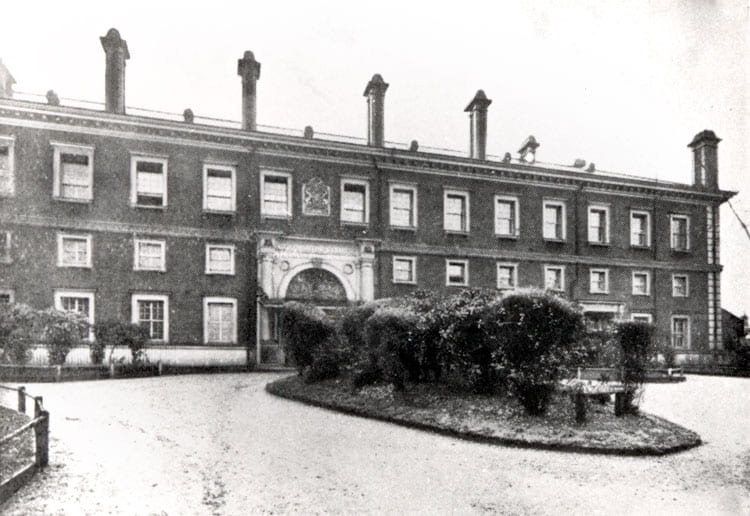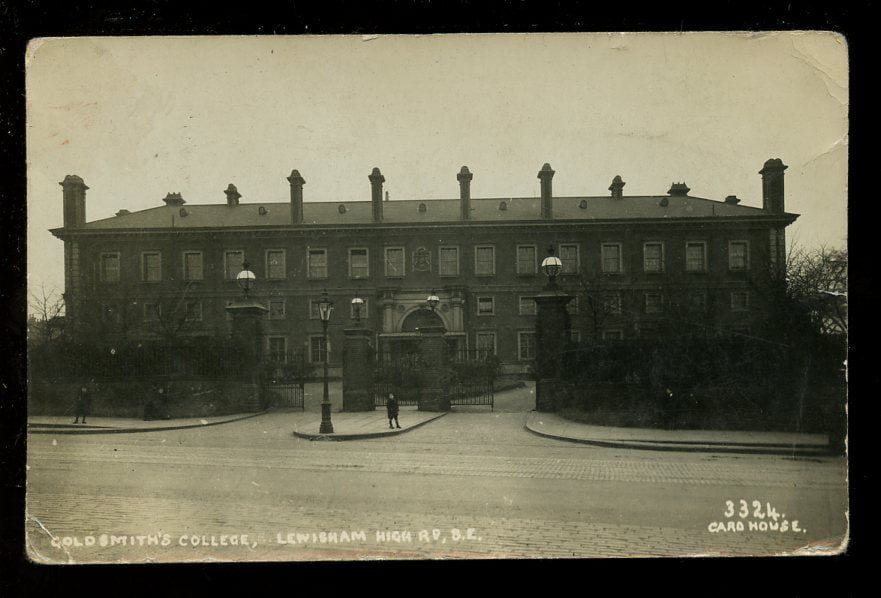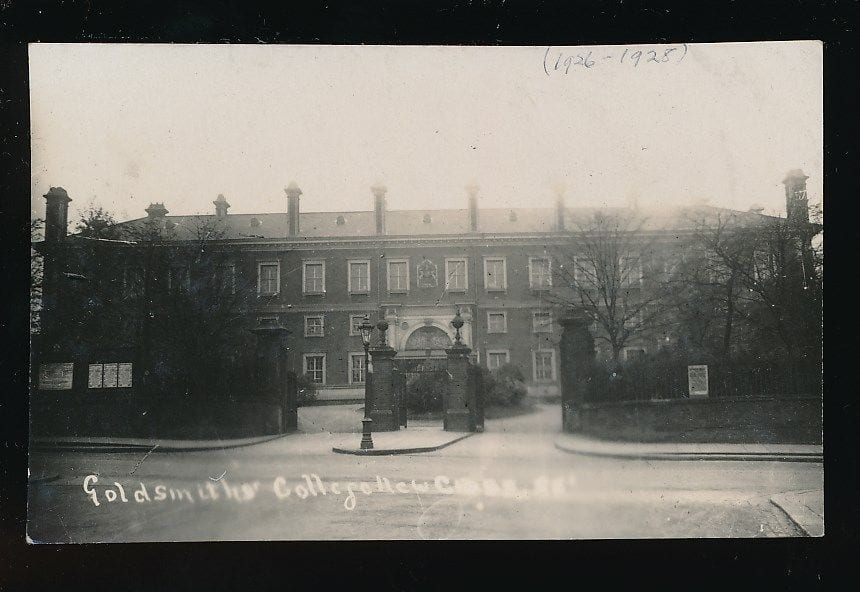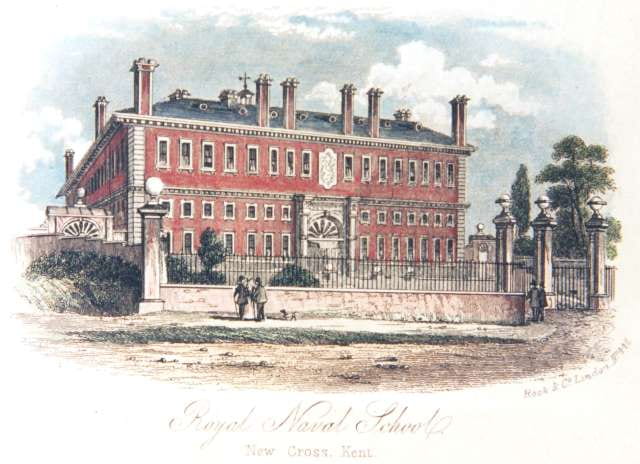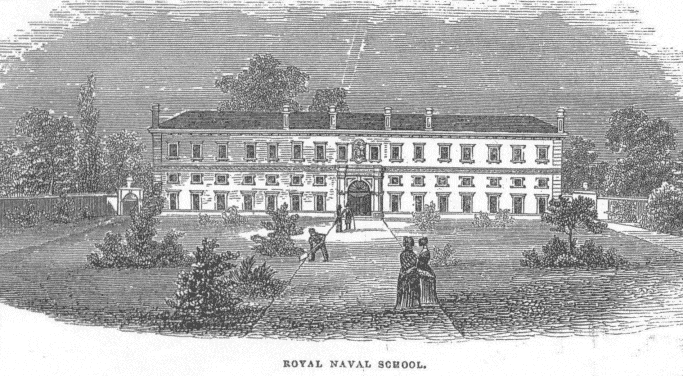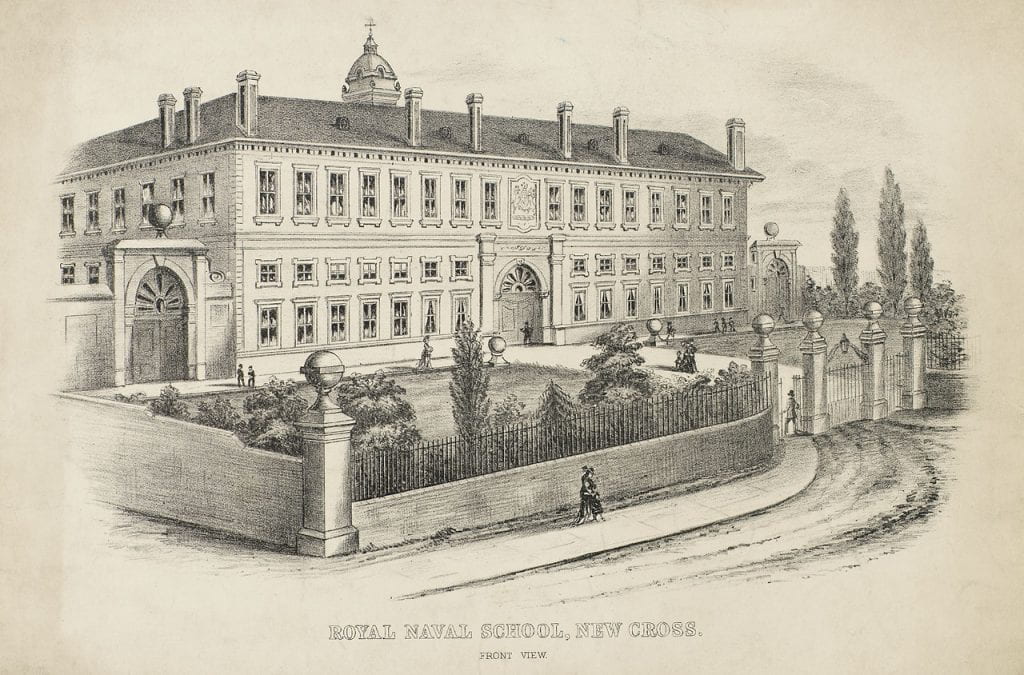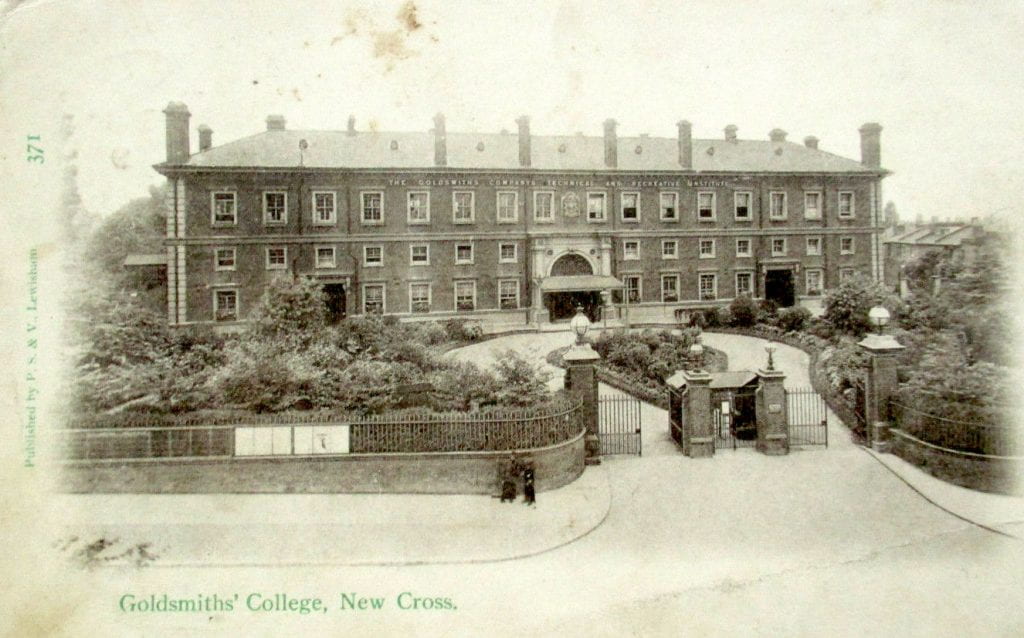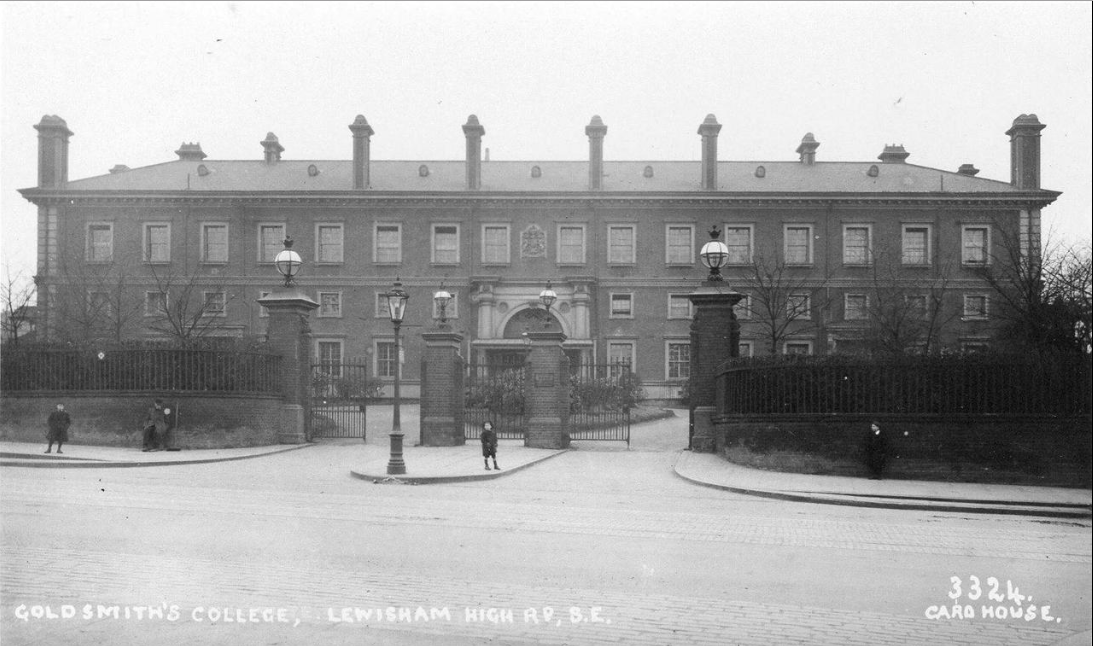
Entrance to Goldsmiths College – a picture taken between 1910 and 1912. Three small boys are standing left, right and centre. To the left of the entry route into the college you can see the figure of a man sitting on a box and the outline of his broom leaning against the wall.
In the early part of Goldsmiths history a character known as ‘The College Beggar’ occupied a makeshift box to the left of the college’s entrance.
Fully equipped with a broom stick he kept the pavement and drive-way of the college clear of rubbish for many years.
He has no name. In the portrait he looks distracted. It is possible his right arm is missing as it does not appear to be present in his apparently empty jacket and coat sleeve.
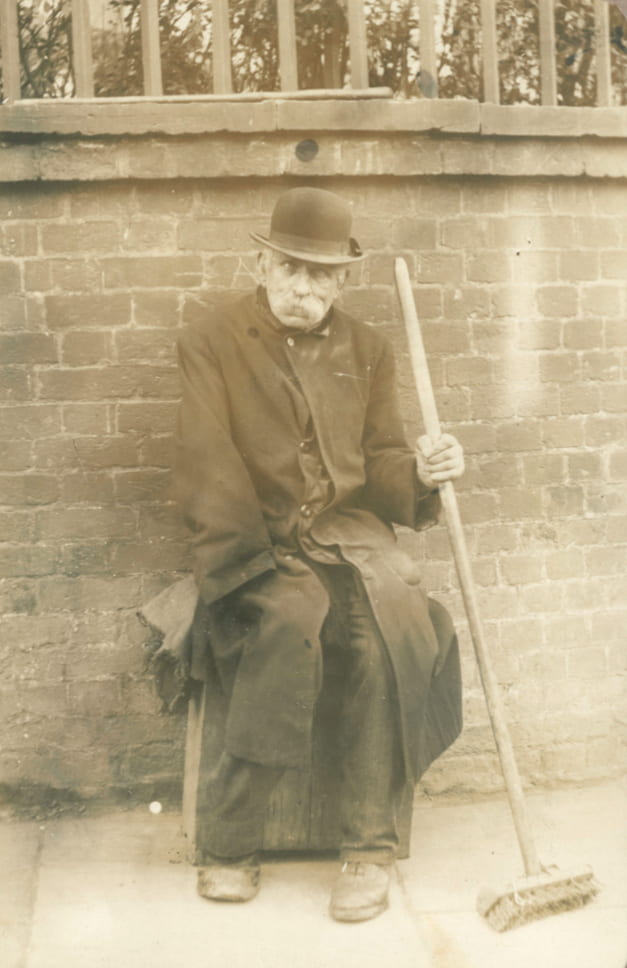
The ‘College Beggar’ outside the entrance of Goldsmiths College 1910-12.
He wears a big, shabby coat and bowler hat. He has a white, long, unkempt, and drooping moustache.
His boots or shoes are worn. His right eye is bright and focused on the camera, but his left eye is closed.
Perhaps he is a wounded and vagrant veteran from some Victorian colonial war.
Had he been a cadet in the Royal Naval School that inaugurated the building from 1844 and was grievously disabled in battle, losing an arm and an eye?
Ex-servicemen have always made up the ranks of the homeless in history.
Who was this elderly gentleman of the road who decided to make this position on Lewisham Way his home?
His presence and character had been so strong that somebody who worked in the college, and was ready to put together a photographic album of its staff, key interiors and locations, decided that he should be included.
That album was acquired by a former Director of Marketing, Recruitment and Communications, Vicky Annand, and donated to the College’s Special Collections and Archives.
There is no doubt he was part of the human geography and architecture of the College.
One of the first issues of the student magazine, Goldsmithian, in February 1907 affectionately included a pencil portrait titled ‘A familiar figure’ and depicting the gentleman gently waving a ‘hello!’ or ‘goodbye!’ at his regular perch.
Curiously, his right arm seems to be present as he is depicted raising it in gesture. The broom and bowler hat, location with broom and box confirm the identification.
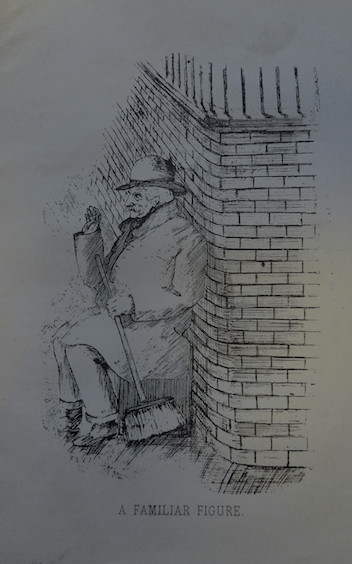
‘A Familiar Figure’- the College beggar drawn for the February issue of 1907 ‘Goldsmithian.’ Image: Copyright Goldsmiths, University of London.
‘The College Beggar’ lived in an age with no welfare apart from the spartan conditions of the Workhouse.
His choice was stark. Either he could submit himself to the mercy of the streets, and any money or food given by generous passersby, or he could surrender to the charity of the Parish.
The poor and destitute of this time had recourse to the Woolwich Road Workhouse and Vanbrugh Hill Infirmary from 1840.
From 1904, paupers could seek admittance to the newly built and opened Grove Park Workhouse run by the Greenwich Guardians.
Blocks for the male and female ‘aged’ were situated at the front of what from a distance might have resembled a country estate, but in reality operated with a rigid regime of restrictions.
This was where poverty was something to be punished rather than relieved.
I like to think ‘The College Beggar’ was a friend of everyone in the college – lecturers, students and support staff.
I imagine that the men and women working in the famous building designed by John Shaw Jr. went out of their way to show him compassion, giving him the dignity of ‘a job’, and making sure he would keep his body and soul together even though he had nowhere to live.
If you have any family diaries and archives that could shed light on the real identity of this man, feel free to email me at t.crook @ gold.ac.uk.
I imagine people did say ‘Good morning Norman’ or ‘Good night Raymond’ as their days of teaching and learning began and ended.
Because of the more formal mode of public address of the time they most probably said ‘Good day Mr Goodwood.’
I also think he was sustained and supported with meals from the college refectory kitchens.
But where did he go after sunset and the temperature dropped below zero?
Was it the local ‘dosshouse’ or ‘spike’ in Carrington Road, first opened in 1903?
The ‘College’ beggar may well have been a part of the local geography for some decades even before the college opened for business in 1905.
His outline and figure appear to be present in a postcard of the Goldsmiths Company’s Technical and Recreative Institute that occupied and developed the building between 1891 to 1904.
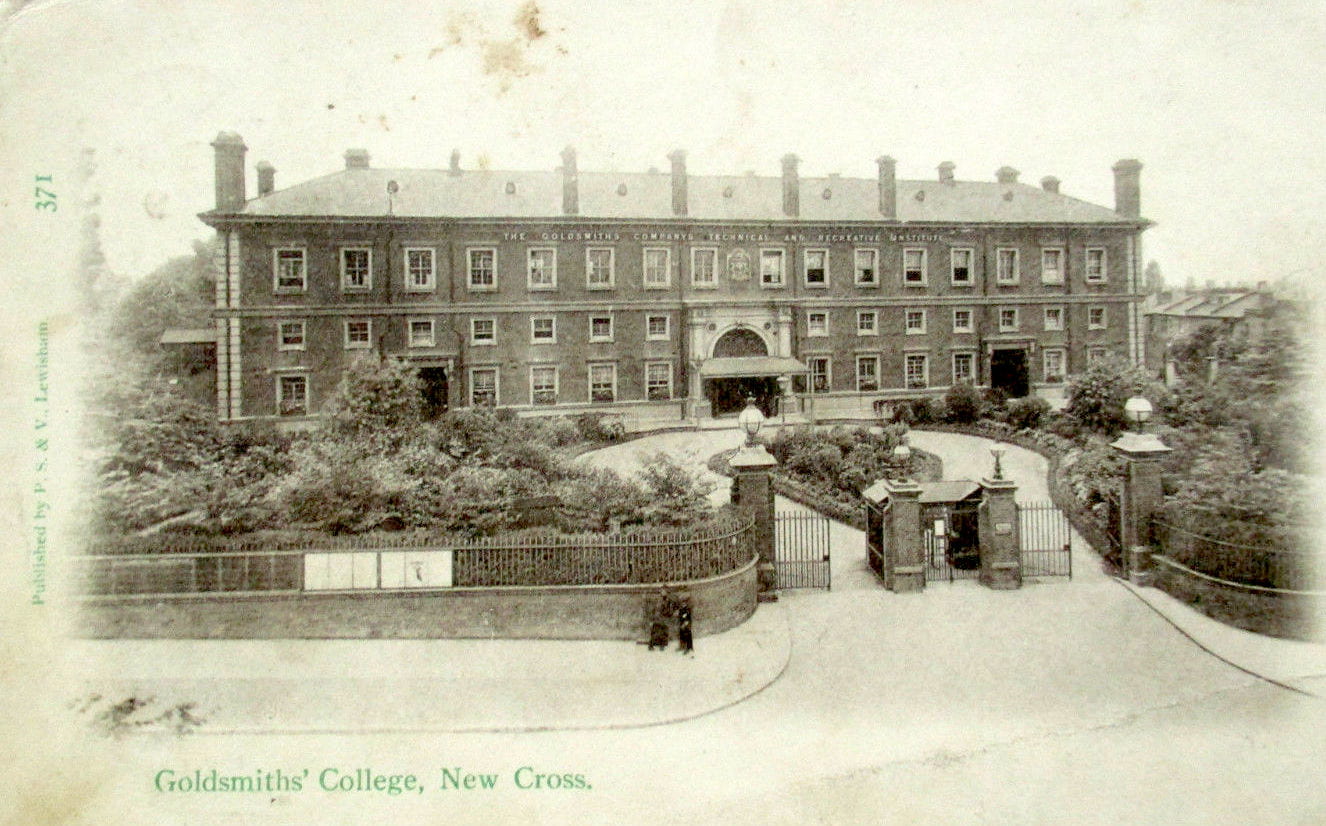
The ‘College Beggar’ sitting on his box does appear to be present in this postcard from 1904 with an image of the College when it was the Goldsmiths Company’s Technical and Recreative Institute.
An etching from circa 1880 mysteriously indicates an outline of the same kind of figure seated, against the wall with what may well be a broom stick by his side.
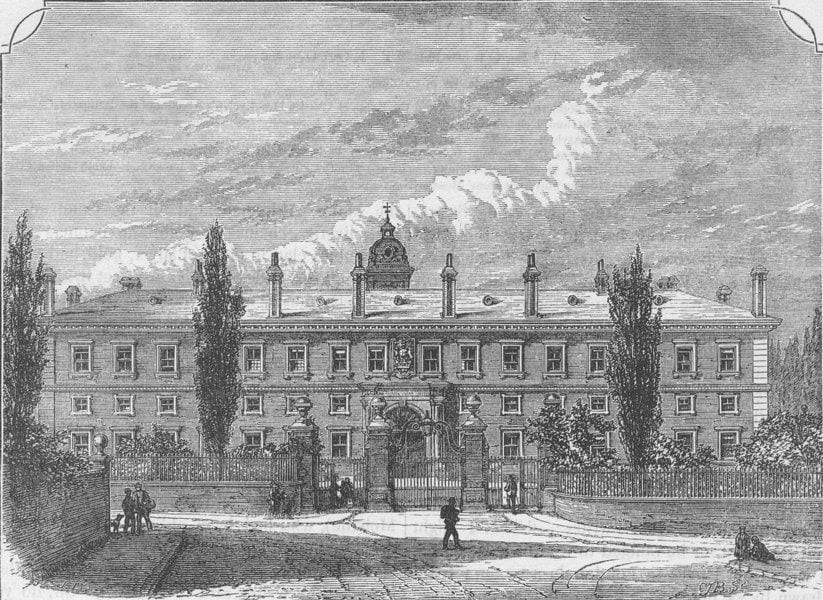
The Goldsmiths College main building in its previous incarnation of the Royal Naval School New Cross c 1880. A seated figure is evident in the same position as that of the ‘College Beggar’ in photographs taken around 1904 and between 1910-12.
It turns out that one of the first intake of Goldsmiths’ College students for September 1905, Frank Colyer, did write about ‘The College Beggar’ many years later for the alumni student association annual Yearbook.
When asked to remember ‘outstanding personalities’ from his time he said he could best recall ‘a Parson, a Bookseller, and a Crossing Sweeper.’
The ‘Crossing Sweeper’ was our ‘College Beggar’ and the old fellow had been ‘Cripps by name’ because ‘he was very crippled and sat on a box on the pavement. In spite of his infirmity he was very cheerful and chatted with many of the students.’
Frank explained that prior to the opening of the College ‘Lewisham Way had been a quiet suburban road, and the main flow of traffic into Kent had been via New Cross Road, and Blackheath Hill’ and ‘it had been so quiet that a crossing sweeper had eked out some sort of livelihood by sweeping a pathway for pedestrians from the College entrance to Park Field Road.’
Frank Colyer would go on to earn an MBE in his teaching career and was a leading figure in the old students’ association.
Those students enrolled in the first year called themselves ‘Aborigines’ on account of being the first student inhabitants of the new Goldsmiths’ College.
The back of the postcard of the Goldsmiths Institute would appear to have been written by one of the first of Goldsmiths College’s students, or perhaps one of the first members of the teaching staff.
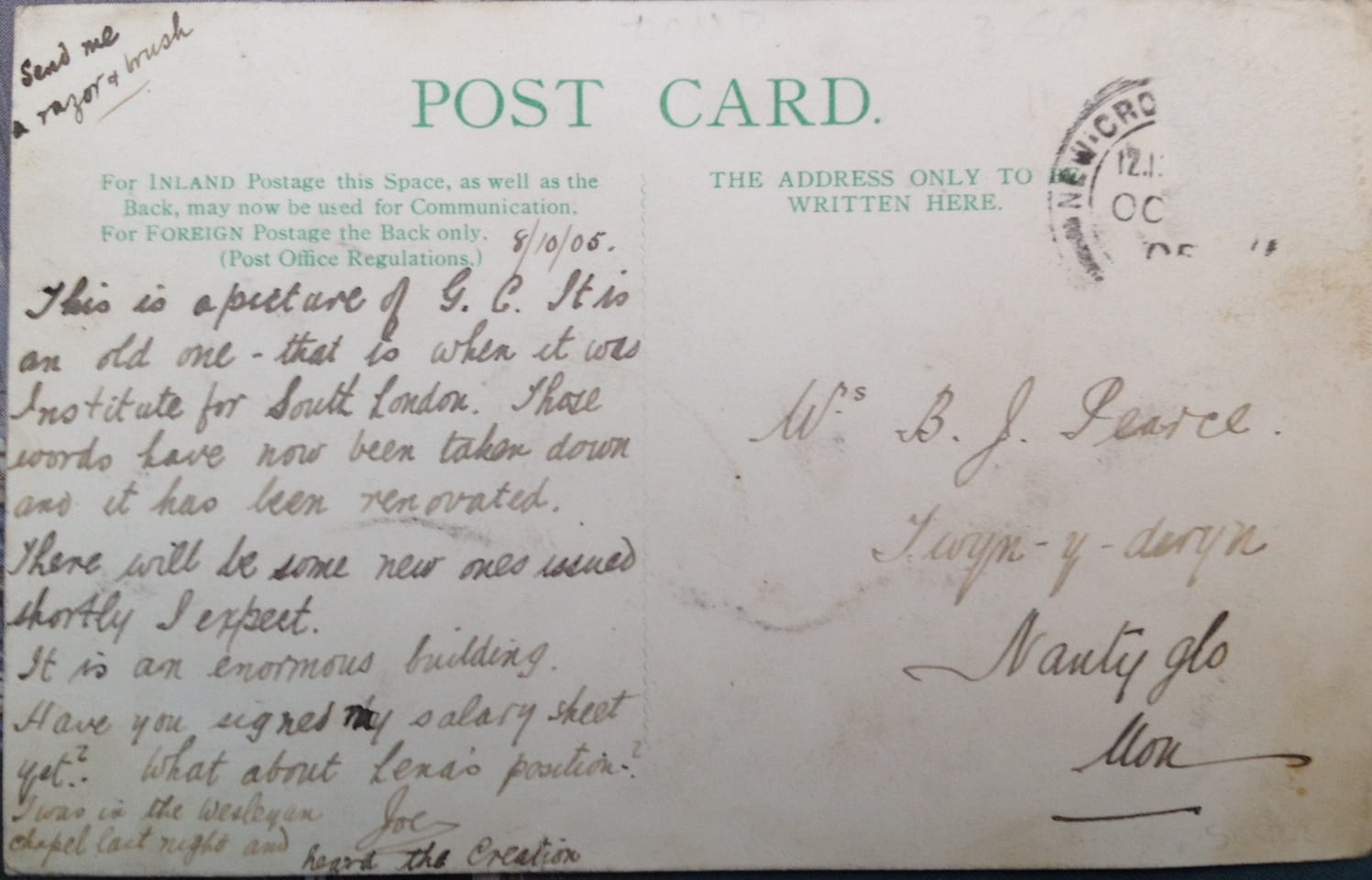
I suspect that the student or teacher is a young man. Note the afterword in the top left hand corner: ‘Send me a razor and brush.’
I also presume he was writing to his mother or wife, Mrs B. J Pearce, in Monmouthshire in Wales.
He has just started his studies, or teaching duties, as his card is dated from the beginning of the first academic year at the College – 8th October 1905.
It is a fascinating insight on the first impression that the building had on the College’s first students and staff travelling across the country to London:
‘This is a picture of G.C (Goldsmiths College). It is an old one – that is when it was Institute for South London. Those words have now been taken down and it has been renovated. There will be new ones issued shortly I suspect. It is an enormous building. Have you signed my salary sheet yet? What about Lena’s position? I was in the Wesleyan Chapel last night and heard the Creation. Joe’
Is it more likely Joe Pearce was writing to his wife?
The style of address seems more like that of a teacher than a student.
Would a student be asking a friend or family member about the signing of a salary sheet?
I intend to find out more about Joe Pearce for the next posting in the Goldsmiths History series.
If you are a descendant of Joe Pearce and know more about his life at Goldsmiths in the first year of its existence, do contact me.
The changing faces of Goldsmiths from 1840s to 1930s
- 1880s
- 1930s
- 1910s
- 1920s
- 1860s
- 1840s
- 1850s
- 1900s
- 1910s
That’s So Goldsmiths– a forthcoming history of the university is being researched and written by Professor Tim Crook.
Goldsmiths History Project Podcast by Professor Tim Crook

